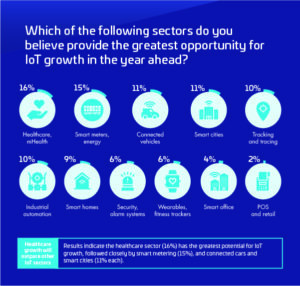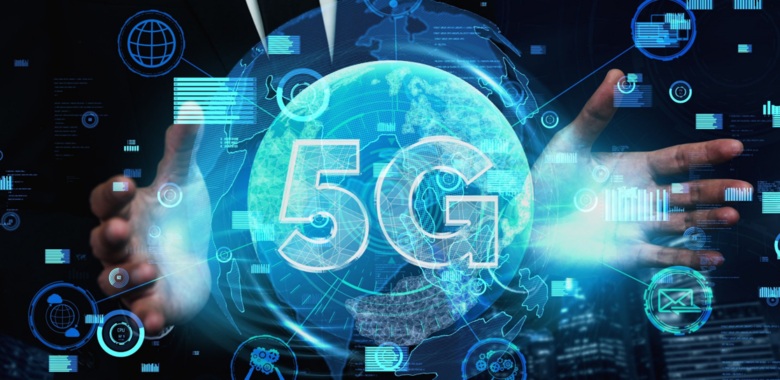If there’s one thing we learned from 2020, it’s to expect the unexpected! As the COVID-19 pandemic spread around the world, nearly every aspect of life was disrupted.
So, with all the uncertainty, why bother with an annual IoT prediction survey?
The IoT is still booming!
Despite the challenges of 2020, the IoT industry is thriving. As the world quickly transitioned to remote work and school, the importance of connected devices has never been more apparent. In fact, IoT Analytics, a leading provider of market insights for the Internet of Things (IoT), M2M, and Industry 4.0, recently noted that 2020 marked a turning point where 12 billion IoT connections surpassed non-IoT connections for the first time in history. One of the lasting legacies of the 2020 pandemic is knowing that digital transformation can happen overnight and innovation can occur faster than we ever thought possible.
With transformation and innovation in mind, we’re excited to share the top results and insights from our IoT Predictions for 2021 Survey.
Connected healthcare, smart energy, and connected cars top the charts for growth
When it came to predicting the IoT segments with the greatest potential for growth, we weren’t surprised that healthcare topped the list followed closely by smart energy, connected cars, and smart city applications. Although all four categories are expanding, a recent Research and Markets report projects the IoT healthcare sector will grow nearly 39% to reach USD $188.2 billion by 2025, up from $72.5 billion at the end of 2020.

As hospitals and physicians were overwhelmed with COVID patients, people with chronic conditions and less serious illnesses had to take a backseat. Patients and practitioners had no choice but to adopt remote consultations and digital treatment methods to address healthcare needs.
For instance, increased use of wearable medical devices and edge computing, are helping physicians track patient conditions in real time so they can provide care as it’s needed. In addition, an increasing number of hospitals are adopting smart technologies, cloud platforms, and connected surgical equipment that leverage AI and real time communications to speed diagnosis, improve treatment or even to conduct remote surgery miles away while reducing costs. Of course, keeping patient health data private and secure is paramount as connected healthcare takes off.
The global energy market is also in the midst of unprecedented growth and transformation, driven by the urgent need to combat climate change. This imperative is driving the introduction of renewable energy production and new business models that incorporate small scale energy producers and energy assets. Both of which are not possible without advanced metering infrastructure. Smart meters are the backbone of the new energy ecosystem and they will continue to leverage LPWAN and low power 5G solutions as the global market continues to expand. As seen with the pandemic, it became even more crucial for grid managers to be able to access and read meters data remotely. Innovation goes into this direction, ensuring always-on connectivity solutions and network resilience.
In the context of new regulation, such as UNECE wp29, the automotive industry is looking at increasing the levels of convenience and comfort of connected vehicles, without compromising safety and data privacy for drivers and passengers. The development of the connected car and, ultimately, autonomous vehicle will depend both on reliable connectivity and a strong cybersecurity architecture, to avoid such connectivity becoming the gateway to cyber-attacks.
IoT security will remain a top priority
By 2025, the GSMA estimates that IoT connections will double from today reaching nearly 25 billion globally; and as connections increase, so does the risk of cyberattacks. Not surprisingly, IoT cybersecurity was a concern for 95% of our survey respondents, with nearly 40% indicating they are “very concerned” about vulnerabilities as the IoT expands. What’s more, 88% of respondents are in favor of IoT security regulations and industry standards to govern cybersecurity best practices. This echoes a recent MarketsandMarkets report which estimates the IoT security market will grow to USD 36.6 billion by 2025, up from 12.5 billion in 2020.
Distributed denial of service (DDoS) attacks and ransomware attacks are a growing threat for poorly protected IoT devices, but the good news is, OEMs can mitigate risk with a straightforward security by design approach. This ensures protection is built in at each stage of product manufacture and implementation, and for the lifetime of an application.
What kind of security is included?

86% of survey respondents believe that digital device IDs and strong authentication technology can protect IoT connected solutions and data from cyberattacks.
They’re right – digital IDs injected into IoT devices during manufacturing and strong authentication technology prevents hackers and unauthorised parties from gaining access to devices and cloud platforms. Solid security architecture implementation is not easy, which is why seeking advice from security experts is crucial to success.
Forging forward with 5G
5G has arrived! And it’s the fastest-growing mobile technology in the history of wireless. Survey respondents (33%) ranked 5G as the most important technology to enable continued IoT expansion and growth, and they also predict 5G will be the most prominent IoT connectivity technology in the next five years (26%). Respondents also indicated that enabling seamless evolution and network switching is equally important to 5G in supporting IoT growth.

How will that play out?
Whereas 2020 was the year MNOs lit up their 5G networks, 2021 will be the year where network readiness and availability come to fruition. The GSMA estimates that 5G connections will grow to reach 1.8 billion by 2025, up from 10 million at the end of 2019. This represents a fundamental change in the mobile ecosystem, unleashing a powerful combination of extraordinary speed, expanded bandwidth, low latency, and increased power and cost efficiency that will drive billions of new IoT connections.
“OEMs that develop high bandwidth IoT applications such as industrial routers and gateways were ready for 5G yesterday! The challenge is they need connectivity solutions that allow easy migration from existing designs,” said Andreas Haegele, Vice President of IoT for Thales. “That’s where technologies such as our award-winning Cinterion® MV31-W IoT 5G Modem Card come in. It provides high-performance 5G enhanced Mobile Broadband (eMBB), delivering fast data speeds and fallback to 4G and 3G networks. The HW design enables smooth migration, whether products are evolving from 2G, 3G, 4G or LTE Advanced.”
LPWAN and 4G going strong
As 5G ramps up, LPWAN and 4G will still play a prominent role in IoT connectivity – and our survey respondents agree rating these technologies just behind 5G. LPWAN and 4G including NB-IoT and LTE-M are part of the low power branch of 5G known as massive Machine Type Communication or mMTC. The main focus of mMTC is to efficiently transmit low data volumes intermittently to and from devices that require wide area coverage and long battery life. With more efficiency comes greater network capacity to serve a huge and higher number of devices for a same area than before. It’s ideal for applications like smart meters and track and trace apps that are not dependent on speed and latency but that need optimal power efficiency.
So, what’s ahead for IoT in 2021? We asked Francis D’Souza, Head of Strategy Analytics and IoT at Thales for his take on survey results.
“Healthcare, smart metering, and connected car technology will definitely show strong growth in the year ahead, further supporting momentum for cellular IoT, with LPWAN, 4G and 5G technologies, while 2G and 3G sunset. You simply can’t beat cellular for network ubiquity, reliability, security and breadth of features.
I also believe the eSIM technology, now adapted for long-life, industrial IoT applications, will strongly change the game. The IoT eSIM supports agile service contracts necessary for resilient network and future-proof applications. Taking smart metering for example, the IoT eSIM greatly improve meter makers and grid managers´ job, by simplifying SKU logistics, connectivity deployment and remote subscription management.
Last year’s mass move to remote work forced accelerated digital transformation that kept the cogs of industry turning while helping to improve productivity, efficiency and business outcomes – the future is bright for IoT technology!”
You can view our full infographic that illustrates the results of our IoT survey here.



